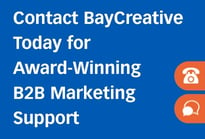When you’re looking for a product or service, what’s the first thing you do 9 out of 10 times? Go online to google (the verb) that product/service so you can research it, get a feel for its value to you, and find out where you can buy it.
Right?
No matter if it’s in their business or personal life, people rely on the Internet to tell them the best brands of products and services. They usually start the process by googling a general term for that product/service. For B2B companies, showing up on the first page of those search results is critically important—the higher in the rankings, the better.
But if consistently addressing search engine optimization (SEO) is too time-intensive, or you don’t have the in-house knowledge to do that, or you just want to double up on the chances a prospect will find you when they’re looking for your product, you can try pay-per-click (PPC) advertising.
PPC 101
PPC stands for “pay-per-click.” In simplistic terms, you create a simple text ad with targeted keywords, and when someone clicks on that ad, you pay the website a small fee. Because you’re paying money per click, the website that is hosting your ad—commonly a search engine, but not always—will place it at the top of the search results, or the top of the page, or in the “news feed.” The more you’re willing to pay per click, the higher you’ll be listed in relation to other companies that have bid on those same keywords.
The top two results are ads that match the keywords “B2B software solutions.”
The Cost-friendliness of B2B PPC Ads
Paying $1 per click, for example, may seem like a lot, but it's really not, compared to the benefits you can receive. The people who click on the ad link tend to be more qualified prospects already looking for your product/service/solution. If not, they won’t click on it, and you won’t have to pay.
If you can convert a fraction of those who click on the ad, you’ll likely make more than enough in sales to make the PPC ad investment worth it.
Because it’s (by far) the most-used search engine in the world, you’d want to focus your PPC campaign on Google Ads. You can also advertise on social media sites and blogs that target the same audience as your marketing efforts.
The Benefits of a PPC Advertising Campaign for B2B Companies
If done right, PPC advertising can offer some enticing benefits for B2B companies:
- They’re cost-effective because you’re only paying when a user clicks on your ad and goes to your landing page or website, rather than paying for the ad to run for a length of time
- You can choose how much to pay
- It’s targeted, so you can choose your audience according to demographics and interests
- You can use PPC ads on many different sites: social media, search engines, blog posts, online newsletters
- It’s measurable, so you can determine how much return you’re getting on your investment
- It’s customizable—if it doesn’t seem to be working, you can make adjustments to improve performance
- You can see the impact of your PPC efforts almost immediately
It’s Not As Easy As it Looks, Though
But, as with any effective marketing strategy, a lot goes into crafting a successful PPC campaign. You’ll need to research and select the right target groups and keywords, write a relevant ad with the keywords in the right places, and make sure the landing page that the ad leads to is optimized for conversions.
That’s where a full-service B2B marketing/branding/creative agency like BayCreative can help. We’re experts in crafting content for a variety of marketing materials, including PPC campaigns. If you’re looking to increase your leads through the use of PPC ads, please let us know.
All the best,
- Team BayCreative -

